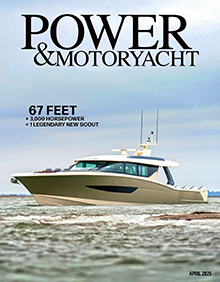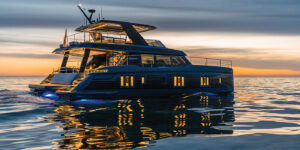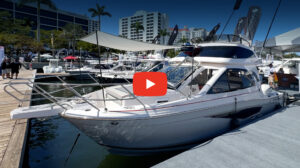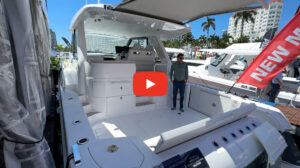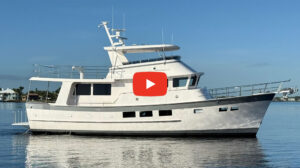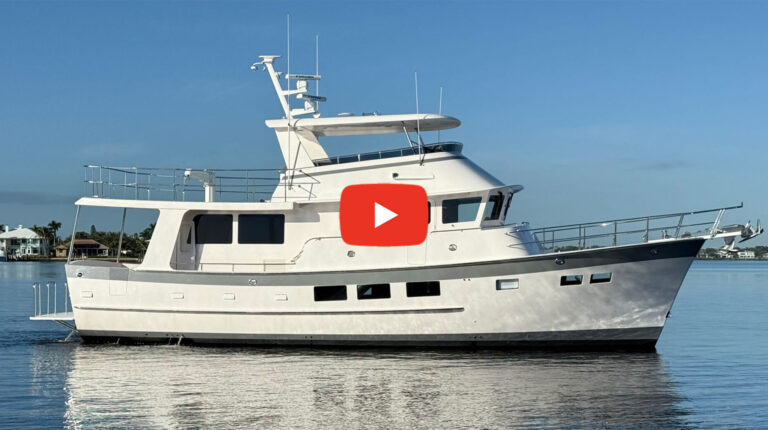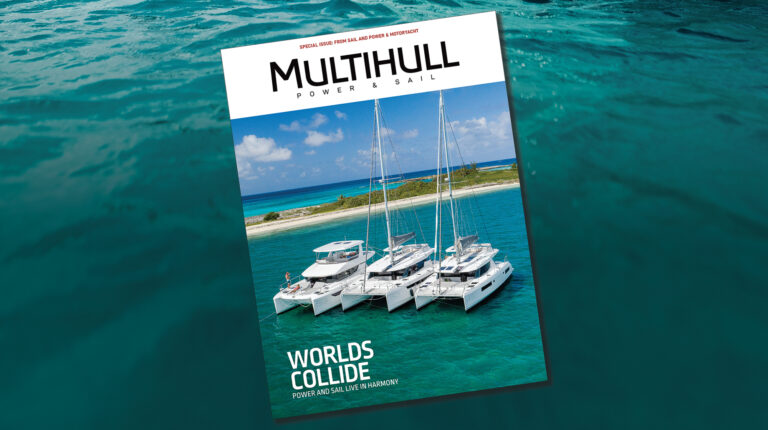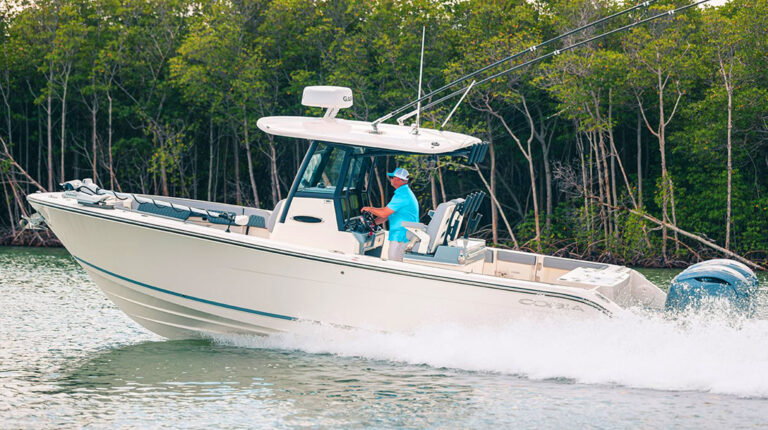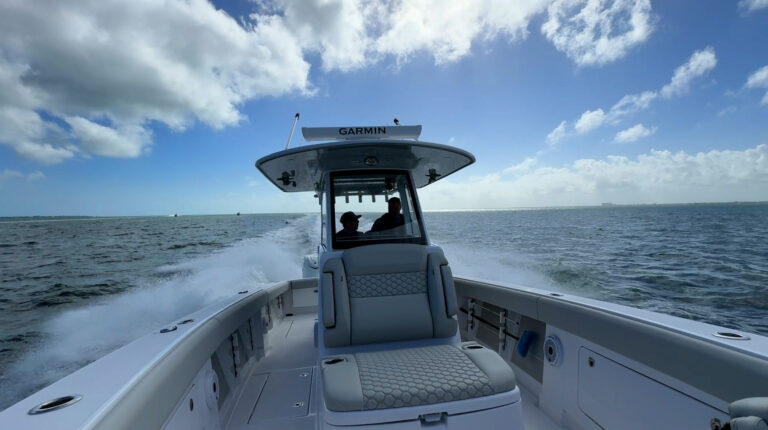Outboard Extremes
Two youthful, highly enthusiastic companies aim two radically different products at two radically different markets.
Right now, the news in outboards isn’t coming from the big manufacturers. Instead, two small companies working at the extremes of the horsepower spectrum are each hoping to be the next big thing. The Seven Marine 557 is fundamentally outrageous—a supercharged V8 rated at 557 horsepower, it will be the most powerful outboard ever offered when it goes into production. Lehr Marine, on the other hand, is looking towards a future of alternative fuel with a pair of dinky kickers powered by clean-burning propane. Though worlds apart in size and performance, Seven and Lehr are equally exciting products, each realized through hard thinking and entrepreneurial zeal.

The rationale for the Seven Marine 557 is that this humongous motor will take the place of two “little outboards.” A boat running four 300-hp motors, for example, could get by with just two Seven 557s and thus have less complex rigging, less drag, and better performance or economy. Of course, that boat could also be rigged with four 557 motors, which is exactly what I’m guessing will happen. Because if you can afford one $70,000 outboard, you can probably afford three or four. And you don’t need to rationalize the purchase.
This 557 is a Midwestern, father-and-son creation. Seven Marine president Rick Davis is a former executive vice president of advanced engineering at Mercury Marine who resigned in 2008 to pursue personal projects. But he credits the 557 outboard concept to his 36-year-old son, Eric, who has not quite finished an engineering degree but still holds 15 patents. (For more on Seven Marine’s genesis, see “The Alpha Outboard” in June 2011.)
The Seven Marine 557 is powered by the supercharged 6.2-liter General Motors LSA engine used in the Cadillac CTS-V, “the smallest, lightest, most torque-dense automotive V8 that we could identify,” says Rick Davis. With the exception of stainless steel exhaust headers and some computer programming, the all-aluminum V8 is unmolested by Seven Marine—it’s the same engine used in the Caddy.
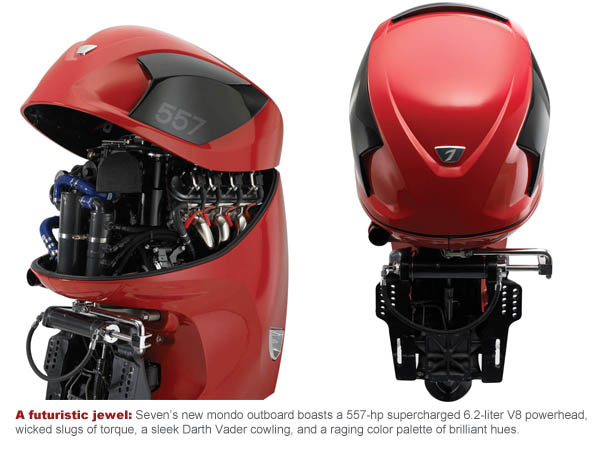
A ZF Marine transmission is located below the engine, and incorporates a 90-degree gearset to get the power headed down to the water. Between the engine and transmission is a transfer case with quick-change gears to better tune the final drive ratio to best match boat weight and speed potential. A twin-pinion gearcase spreads out the load of 550 foot-pounds of torque. The package also includes closed cooling, drive-by-wire throttle and shift, and an integral power-steering system designed by Latham. Hering Performance Propellers will supply the props.
A single Seven 557 made its in-water debut at this year’s Miami International Boat Show on a Sea Hunter 29, a wide-beam center console typically rigged with twin 300-hp motors. I got a brief ride-along and took the helm for one run up to about 57 knots. This is no snarling, high-strung race motor. It sounds smooth and sophisticated. The power is unrelenting. Of course, under the motor’s eggshell-blue cowl was a prototype powerhead and running gear that had logged many hours of testing and sea trials, so let’s wait to run a real production version to truly gauge the performance potential of the Seven 557.
According to Davis, the motors will be built in 25-unit batches, each to order and painted to customer specification. He adds that deposits are in hand for the first production runs. Some motors are for repowers, while others are being specified for new boats under construction. More than a few are headed for, no surprise—the Persian Gulf.

“The Middle East is setting the curve in terms of the size of outboard boats,” says Davis, “with 52-foot center consoles already on their waterways. They are thus very hungry for 557s to become available.”
An outboard that runs on propane
My introduction to Lehr CEO and founder Capt. Bernardo Herzer took place at the Miami Show as well. He was pulling the rope on one of his little green motors at the time, starting it in a tank … indoors at the convention center.

“They let you do that?” I asked of the entrepreneurial Californian.
“It runs on propane!” he fired back. “Same as all the forklifts that set up this show.”
Why hasn’t anyone else powered an outboard with propane? According to the government and propane-industry data, more than 700 million gallons of propane is used for engine fuel annually in the U.S., about 2 percent of total energy consumption. Propane powers 670,000 forklifts and 270,000 motor vehicles in the U.S. Worldwide, propane is the third most-common engine fuel (behind gasoline and diesel) and powers more than 13 million vehicles. Propane vehicles emit 12 percent less carbon dioxide, about 20 percent less nitrogen oxide, and up to 60 percent less carbon monoxide than gas-powered vehicles. Moreover, propane is nontoxic, it’s not a greenhouse gas, produces no evaporative emissions, and it will not damage marine life. Ninety percent of the U.S. propane supply is produced domestically as a byproduct of natural-gas and crude-oil refining. It’s not made from corn. Propane won’t go stale or gum up a carburetor.
Herzer is a propane evangelist, and his first products were a line of Lehr garden tools—a leaf blower, string trimmer, and lawn mower—introduced a few years ago. Like his outboards, these products run on the one-pound cylinders also used for camp stoves and lanterns. Lehr outboards can also be fueled from portable tanks like you’d use for a gas grill. The patented fuel-metering system looks like the combination of a BBQ grill regulator and a moped carburetor. The 2.5-hp Lehr LP2.5 ($1,200) has a 72cc four-stroke powerhead, F-N shifting, and weighs 37.4 pounds. The 5.0-hp Lehr LP5.0 ($1,920) displaces 112cc, has F-N-R shifting, and weighs 49.6 pounds with a short shaft. By weight and features, Lehr outboards are similar to the Yamaha F6 ($1,915), the Mercury 2.5 ($1,000), and the Mercury 5 ($1,750). Lehr outboards are assembled in China with components sourced around the world.
Where I live in Wisconsin it costs about $20 to fill a 4.7-gallon, 20-pound propane tank—that’s about $4.25 a gallon. I can buy a one-pounder for $3.00—which works out to about $12.75 a gallon—and you have to dispose of the empty cylinder (Lehr is working on a refillable one-pounder). But then, propane is a clean, convenient, and very portable fuel. Lehr says the LP2.5 will run for an hour at WOT on a one-pound cylinder, the LP5.0 about 30 minutes. If you are using a motor just to get to a mooring, these scenarios may be fine. Of course, you could also row.
Lehr let me try the LP2.5 for an afternoon on my 12-foot aluminum rowboat. It’s pretty easy to attach the fuel cylinder, though you may get a little spritz of propane on your fingers in the process. The motor started consistently on two easy pulls. Throttle control was good and while the LP2.5 would not plane my boat (just as I expected), I could move right along into a little headwind. The motor is well finished with the exception of the plastic cowl latches, which look like they won’t last long. I’m told they will be upgraded. The motor also seems a little noisy. Some insulation under the plastic cowl might help. “Low-impact” products should be clean and quiet. Right now there are no prop options for either Lehr model.

I’m told there’s been great interest in the Lehr motors from boaters who hate gasoline. You know—sailors and maybe cruisers who use an outboard as auxiliary power or for a small tender. Keeping gas onboard can be a fire hazard and it stinks, and many of these folks are already using propane for cooking and heating fuel anyway. I transported the Lehr outboard in the cab of my truck for more than an hour, and never got a whiff of fuel odor. Try that with a gasoline outboard.

If all goes well, by the end of this summer both Lehr and Seven Marine will have filled orders for their new outboards. As I write this in April, the first containers of Lehr motors are being offloaded in New Orleans and trucked to distributors. Expect to see more propane-powered outboards from Lehr soon, starting with a 9.9-hp model. Seven Marine is tooling up production in suburban Milwaukee to deliver motors before Labor Day. So, we’ve got a propane pundit from California building green outboards in China, and industry veterans building a monster motor in Wisconsin for speedboaters in Dubai. These days, it would seem, outboards are really getting around.
Seven Marine,
877-777-0330
Click here to visit Seven Marine’s website
Lehr,
310-839-9009
Click here to visit Lehr’s website
This article originally appeared in the June 2012 issue of Power & Motoryacht magazine.

